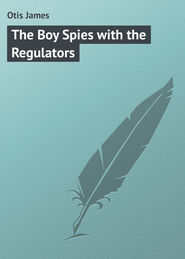По всем вопросам обращайтесь на: info@litportal.ru
(©) 2003-2025.
✖
The Boys of '98
Настройки чтения
Размер шрифта
Высота строк
Поля
During the evening the tiny steamer Mangrove, a lighthouse tender, captured the richest prize of the war thus far, when she hove to the Panama, a big transatlantic liner, and an auxiliary cruiser of the Spanish navy, which had been plying between New York and Havana.
The Mangrove, Lieut. – Commander William H. Everett commanding, was cruising along the Cuban coast about twenty miles from Havana when she sighted the big steamer, which was armed with two 12-pounders. As the latter came within range the Mangrove sent a shot across her bow; but the Spaniard gave no heed; another missile followed without result, and the third whistled in the air when the two vessels were hardly more than a hundred yards apart, Commander Everett shouting, as the report of the gun died away, that unless the steamer surrendered she would be sunk forthwith.
The only other ship of the fleet in sight was the battle-ship Indiana, three miles to the rear. The Mangrove’s officers admit that they expected the enemy’s 12-pounders to open on them in response to the threat, but the Spaniard promptly came to. Ensign Dayton boarded the prize.
The Indiana had seen the capture, and meanwhile drew up to the Mangrove, giving her a lusty cheer. Lieutenant-Commander Everett reported to Captain Taylor of the battle-ship, and the latter put a prize-crew on board the captive, consisting of Cadet Falconer and fifteen marines.
April 26. The President issued a proclamation respecting the rights of Spanish vessels then in, or bound to, ports in the United States, and also with regard to the right of search.
The United States gunboat Newport carried into Key West the Spanish schooner Piereno and the sloop Paquette, which she captured off Havana, while the monitor Terror took to the same port the coasting steamer Ambrosia Bolivar. This last prize had on board silver specie to the amount of seventy thousand dollars, three hundred casks of wine, and a cargo of bananas.
April 27. The steamers New York, Puritan, and Cincinnati bombarded the forts at the mouth of Matanzas Harbour. The engagement commenced at 12.57, and ceased at 1.15 P. M. The object of the attack was to prevent the completion of the earthworks at Punta Gorda.
A battery on the eastward arm of the bay opened fire on the flag-ship, and this was also shelled. Twelve 8-inch shells were fired from the eastern forts, but all fell short. About five or six light shells were fired from the half completed batteries. Two of these whizzed over the New York, and one fell short.
The ships left the bay for the open sea, the object of discovering the whereabouts of the batteries having been accomplished. In the neighbourhood of three hundred shots were put on land from the three ships at a range of from four thousand to seven thousand yards. No casualties on the American side.
The little monitor Terror captured her third prize, and the story of the chase is thus told by an eye-witness:
“The Spanish steamer Guido, Captain Armarechia, was bound for Havana. There was Spanish urgency that she should reach that port. Aboard was a large cargo, provisions for the beleaguered city, money for the Spanish troops – or officers. The steamer had left Liverpool on April 2d, and Corunna on April 9th.
“Ten miles off Cardenas, in the early morning, the Guido, setting her fastest pace, made for Havana and the guardian guns of Morro. Ten miles off Cardenas plodded the heavy monitor. The half light betrayed the fugitive, and the pursuit was begun.
“Slowly, very slowly, the monitor gained. It would be a long chase. Men in the engine-room toiled like galley-slaves under the whip. There was prize-money to be gained. The Guido fled fast. Every light aboard her was hid.
“Reluctantly the pursuer aimed a 6-pounder. It was prize aim, and the shot found more than a billet in the Guido’s pilot-house. It tore a part away; the splinters flew.
“Another 6-pounder, and another. It was profitable shooting. The pilot-house, a fair mark, was piece by piece nearly destroyed. Jagged bits of wood floated in the steamer’s wake.
“The gunboat Machias, which was some distance away, heard the sound of the firing, came up, and brought her 4-inch rifle into play, firing one shot, which failed to hit the Spaniard. This, however, brought her to, and Lieutenant Qualto and a prize-crew were put on board.”
A cablegram from Hongkong announced the capture of the American bark Saranac off Manila, by the Spanish gunboat El Correo.
By a conference of both branches of Congress a naval bill of $49,277,558 was agreed upon. It stands as the heaviest naval outlay since the civil war, providing for the construction of three battle-ships, four monitors, sixteen torpedo-boat destroyers, and twelve torpedo-boats.
The U. S. S. Newport captured the Spanish sloop Engracia, and the U. S. S. Dolphin made a prize of the Spanish schooner Lola.
April 29. The flag-ship New York was lying about two miles off the harbour of Cabanas, having just completed a cruise of inspection. With her were the torpedo-boats Porter and Ericsson. On the shore could be seen the white ruins of what may have been the dwelling of a plantation. No signs of life were visible. It was as if war’s alarms had never been heard on this portion of the island.
Suddenly a volley of musketry rang out, repeated again and again, at regular intervals, and the tiny jets of water which were sent up by the bullets told that, concealed near about the ruins of the hacienda, a troop of Spanish soldiers were making what possibly they may have believed to be an attack upon the big war-ship. It was much as if a swarm of gnats had set about endeavouring to worry an elephant, and likely to have as little effect; yet Rear-Admiral Sampson believed it was necessary to teach the enemy that any playing at war, however harmless, was dangerous to themselves, and he ordered that the port battery be manned.
Half a dozen shots from the 4-inch guns were considered sufficient, although there was no evidence any execution had been done, and the big vessel’s bow was turned eastward just as a troop of Spanish cavalry rode rapidly away from the ruin. The horsemen served as a target for a 4-inch gun in the starboard battery, and the troop dispersed in hot haste.
While this mimic warfare was being carried on off Cabanas, a most important capture was made. The Nashville, Marblehead, and the Eagle left the station on the north coast, April 25th, to blockade Cienfuegos, arriving at the latter place on the twenty-eighth.
They spent the day reconnoitring, and, next morning, in order to get better information, steamed close to the mouth of the harbour of Cienfuegos. The Eagle was to the eastward, and in the van. The Marblehead was slightly in the rear, and the Nashville to the westward.
All were cleared for action. Suddenly smoke was seen rising on the western horizon, and the Nashville, because of her position, put on all steam in that direction. Twenty minutes later she fired two shots across the bow of the coming steamer, which promptly hove to. She was the Argonauta. Ensign Keunzli was sent with a prize-crew of nine to take possession of her.
Learning that Spanish soldiers were on board, word was given to send them to the Nashville immediately as prisoners of war, and when this had been done arrangements were made to transfer the passengers and non-combatants to the shore. The women and children were placed in the first boat, and under cover of a flag of truce were soon bound toward the entrance to Cienfuegos. A second crew took the other passengers and landed them about noon.
The Argonauta had on board Colonel Corijo of the Third Spanish Cavalry, his first lieutenant, sergeant-major, seven other lieutenants, and ten privates and non-commissioned officers. The steamer also carried a large cargo of arms and Mauser ammunition. She was bound from Satabanao, Spain, for Cienfuegos, stopping at Port Louis, Trinidad, and Manzanillo.
Half an hour later the Eagle hoisted a signal conveying the intelligence that she had been fired upon by Spanish boats coming out of the river. She immediately returned the fire with the 6-pounders, and held her ground until the Marblehead came up. Both vessels then fired broadside after broadside up the entrance to the river.
The boats coming down were two torpedo-boats and one torpedo-boat destroyer. After twenty minutes of firing by the Eagle, during the last five of which the Marblehead participated, the Spanish vessels ceased firing.
April 29. A cablegram from St. Vincent, Cape Verde, reported the departure from that port of the Spanish squadron, consisting of the first-class cruisers Vizcaya, Almirante Oquendo, Infanta Maria Teresa, and Cristobal Colon, and the three torpedo-boat destroyers Furor, Terror, and Pluton, bound westward, probably for Porto Rico.
April 30. The American schooner Ann Louisa Lockwood was taken by the Spaniards off Mole St. Nicolas.
The capture of a small Spanish schooner, the Mascota, near Havana, by the torpedo-boat Foote, closed the record of the month of April.
Anxiously awaiting some word from Manila were the people of the United States, and it was as if everything else was relegated to the background until information could be had regarding that American fleet which sailed from Mirs Bay, in the China Sea, on the afternoon of April 27th.
CHAPTER IV.
THE BATTLE OF MANILA BAY
May 1. “Manila, May 1. – The squadron arrived at Manila at daybreak this morning. Immediately engaged the enemy, and destroyed the following Spanish vessels: Isla de Cuba, Isla de Luzon, Reina Christina, Castilla, Don Antonio d’Ulloa, Don Juan d’Austria, Velasco, General Lezo, El Correo, Marques del Duero, Isla de Mindanao, and the water-battery at Cavite. The squadron is uninjured. Few men were slightly injured. The only means of telegraphing is to American consulate, Hongkong. I shall communicate with him.
“Dewey.”
All the world loves a hero, but idolises him when he performs his deeds of valour without too many preliminaries, and, therefore, when on the seventh of May the telegram quoted above was flashed over the wires to an anxiously expectant people, it was as if all the country remembered but one name, – that of Dewey.
April 25. It was known to the public that the Asiatic Squadron had sailed from Hongkong on the 25th of April to avoid possible complications such as might arise in a neutral port, and had rendezvoused in Mirs Bay, there to await orders from the government at Washington.
April 26. So also was it known that on the next day Commodore Dewey received the following cablegram.
“Washington, April 26th.
“Dewey, Asiatic Squadron: – Commence operations at once, particularly against Spanish fleet. You must capture or destroy them.
“Mckinley.”
April 27. On the twenty-seventh came information from Hongkong that the squadron had put to sea, and from that day until the seventh of May no word regarding the commodore’s movements had been received, save through Spanish sources.
Then came a cablegram containing the bare facts concerning the most complete naval victory the world had ever known. It was the first engagement of the war, and a crushing defeat for the enemy. It is not strange that the people, literally overwhelmed with joy, gave little heed to the movements of our forces elsewhere until the details of this marvellous fight could be sent under the oceans and across the countries, thousands of leagues in distance, describing the deeds of the heroes who had made their names famous so long as history shall exist.
During such time of waiting all were eager to familiarise themselves with the theatre of this scene of action, and every source of information was applied to until the bay of Manila had become as well known as the nearest home waters.
For a better understanding of the battle a rough diagram of the bay, from the entrance as far as the city of Manila, may not come amiss.
Twenty-six miles from the entrance to the bay is situated the city of Manila, through which the river Pasig runs, dividing what is known as the old city from the new, and forming several small islands.
Sixteen miles from the sea is the town and arsenal of Cavite, which, projecting as it does from the mainland, forms a most commodious and safe harbour. Cavite was well fortified, and directly opposite its fort, on the mainland, was a heavy mortar battery. Between the arsenal and the city was a Krupp battery, at what was known as the Luneta Fort, while further toward the sea, extending from Cavite to the outermost portion of Limbones Point, were shore-batteries, – formidable forts, so it had been given out by the Spanish government, such as would render the city of Manila impregnable.
Between Limbones and Talago Point are two islands, Corregidor and Caballo, which divide the entrance of the bay into three channels. On each of these islands is a lighthouse, and it was said that both were strongly fortified with modern guns. North of Corregidor, nearly opposite, but on the inner shore, is the point of San José, where was another water-battery mounting formidable guns. That channel between Corregidor and San José Point is known as the Boca Grande, and is nearly two miles wide. The middle channel, or the one situated between the two islands, is shallow, and but little used. The third, which separates Caballo Island from Limbones Point, is nearly three miles in width, at least twenty fathoms deep, and known as the Boca Chica.
The Mangrove, Lieut. – Commander William H. Everett commanding, was cruising along the Cuban coast about twenty miles from Havana when she sighted the big steamer, which was armed with two 12-pounders. As the latter came within range the Mangrove sent a shot across her bow; but the Spaniard gave no heed; another missile followed without result, and the third whistled in the air when the two vessels were hardly more than a hundred yards apart, Commander Everett shouting, as the report of the gun died away, that unless the steamer surrendered she would be sunk forthwith.
The only other ship of the fleet in sight was the battle-ship Indiana, three miles to the rear. The Mangrove’s officers admit that they expected the enemy’s 12-pounders to open on them in response to the threat, but the Spaniard promptly came to. Ensign Dayton boarded the prize.
The Indiana had seen the capture, and meanwhile drew up to the Mangrove, giving her a lusty cheer. Lieutenant-Commander Everett reported to Captain Taylor of the battle-ship, and the latter put a prize-crew on board the captive, consisting of Cadet Falconer and fifteen marines.
April 26. The President issued a proclamation respecting the rights of Spanish vessels then in, or bound to, ports in the United States, and also with regard to the right of search.
The United States gunboat Newport carried into Key West the Spanish schooner Piereno and the sloop Paquette, which she captured off Havana, while the monitor Terror took to the same port the coasting steamer Ambrosia Bolivar. This last prize had on board silver specie to the amount of seventy thousand dollars, three hundred casks of wine, and a cargo of bananas.
April 27. The steamers New York, Puritan, and Cincinnati bombarded the forts at the mouth of Matanzas Harbour. The engagement commenced at 12.57, and ceased at 1.15 P. M. The object of the attack was to prevent the completion of the earthworks at Punta Gorda.
A battery on the eastward arm of the bay opened fire on the flag-ship, and this was also shelled. Twelve 8-inch shells were fired from the eastern forts, but all fell short. About five or six light shells were fired from the half completed batteries. Two of these whizzed over the New York, and one fell short.
The ships left the bay for the open sea, the object of discovering the whereabouts of the batteries having been accomplished. In the neighbourhood of three hundred shots were put on land from the three ships at a range of from four thousand to seven thousand yards. No casualties on the American side.
The little monitor Terror captured her third prize, and the story of the chase is thus told by an eye-witness:
“The Spanish steamer Guido, Captain Armarechia, was bound for Havana. There was Spanish urgency that she should reach that port. Aboard was a large cargo, provisions for the beleaguered city, money for the Spanish troops – or officers. The steamer had left Liverpool on April 2d, and Corunna on April 9th.
“Ten miles off Cardenas, in the early morning, the Guido, setting her fastest pace, made for Havana and the guardian guns of Morro. Ten miles off Cardenas plodded the heavy monitor. The half light betrayed the fugitive, and the pursuit was begun.
“Slowly, very slowly, the monitor gained. It would be a long chase. Men in the engine-room toiled like galley-slaves under the whip. There was prize-money to be gained. The Guido fled fast. Every light aboard her was hid.
“Reluctantly the pursuer aimed a 6-pounder. It was prize aim, and the shot found more than a billet in the Guido’s pilot-house. It tore a part away; the splinters flew.
“Another 6-pounder, and another. It was profitable shooting. The pilot-house, a fair mark, was piece by piece nearly destroyed. Jagged bits of wood floated in the steamer’s wake.
“The gunboat Machias, which was some distance away, heard the sound of the firing, came up, and brought her 4-inch rifle into play, firing one shot, which failed to hit the Spaniard. This, however, brought her to, and Lieutenant Qualto and a prize-crew were put on board.”
A cablegram from Hongkong announced the capture of the American bark Saranac off Manila, by the Spanish gunboat El Correo.
By a conference of both branches of Congress a naval bill of $49,277,558 was agreed upon. It stands as the heaviest naval outlay since the civil war, providing for the construction of three battle-ships, four monitors, sixteen torpedo-boat destroyers, and twelve torpedo-boats.
The U. S. S. Newport captured the Spanish sloop Engracia, and the U. S. S. Dolphin made a prize of the Spanish schooner Lola.
April 29. The flag-ship New York was lying about two miles off the harbour of Cabanas, having just completed a cruise of inspection. With her were the torpedo-boats Porter and Ericsson. On the shore could be seen the white ruins of what may have been the dwelling of a plantation. No signs of life were visible. It was as if war’s alarms had never been heard on this portion of the island.
Suddenly a volley of musketry rang out, repeated again and again, at regular intervals, and the tiny jets of water which were sent up by the bullets told that, concealed near about the ruins of the hacienda, a troop of Spanish soldiers were making what possibly they may have believed to be an attack upon the big war-ship. It was much as if a swarm of gnats had set about endeavouring to worry an elephant, and likely to have as little effect; yet Rear-Admiral Sampson believed it was necessary to teach the enemy that any playing at war, however harmless, was dangerous to themselves, and he ordered that the port battery be manned.
Half a dozen shots from the 4-inch guns were considered sufficient, although there was no evidence any execution had been done, and the big vessel’s bow was turned eastward just as a troop of Spanish cavalry rode rapidly away from the ruin. The horsemen served as a target for a 4-inch gun in the starboard battery, and the troop dispersed in hot haste.
While this mimic warfare was being carried on off Cabanas, a most important capture was made. The Nashville, Marblehead, and the Eagle left the station on the north coast, April 25th, to blockade Cienfuegos, arriving at the latter place on the twenty-eighth.
They spent the day reconnoitring, and, next morning, in order to get better information, steamed close to the mouth of the harbour of Cienfuegos. The Eagle was to the eastward, and in the van. The Marblehead was slightly in the rear, and the Nashville to the westward.
All were cleared for action. Suddenly smoke was seen rising on the western horizon, and the Nashville, because of her position, put on all steam in that direction. Twenty minutes later she fired two shots across the bow of the coming steamer, which promptly hove to. She was the Argonauta. Ensign Keunzli was sent with a prize-crew of nine to take possession of her.
Learning that Spanish soldiers were on board, word was given to send them to the Nashville immediately as prisoners of war, and when this had been done arrangements were made to transfer the passengers and non-combatants to the shore. The women and children were placed in the first boat, and under cover of a flag of truce were soon bound toward the entrance to Cienfuegos. A second crew took the other passengers and landed them about noon.
The Argonauta had on board Colonel Corijo of the Third Spanish Cavalry, his first lieutenant, sergeant-major, seven other lieutenants, and ten privates and non-commissioned officers. The steamer also carried a large cargo of arms and Mauser ammunition. She was bound from Satabanao, Spain, for Cienfuegos, stopping at Port Louis, Trinidad, and Manzanillo.
Half an hour later the Eagle hoisted a signal conveying the intelligence that she had been fired upon by Spanish boats coming out of the river. She immediately returned the fire with the 6-pounders, and held her ground until the Marblehead came up. Both vessels then fired broadside after broadside up the entrance to the river.
The boats coming down were two torpedo-boats and one torpedo-boat destroyer. After twenty minutes of firing by the Eagle, during the last five of which the Marblehead participated, the Spanish vessels ceased firing.
April 29. A cablegram from St. Vincent, Cape Verde, reported the departure from that port of the Spanish squadron, consisting of the first-class cruisers Vizcaya, Almirante Oquendo, Infanta Maria Teresa, and Cristobal Colon, and the three torpedo-boat destroyers Furor, Terror, and Pluton, bound westward, probably for Porto Rico.
April 30. The American schooner Ann Louisa Lockwood was taken by the Spaniards off Mole St. Nicolas.
The capture of a small Spanish schooner, the Mascota, near Havana, by the torpedo-boat Foote, closed the record of the month of April.
Anxiously awaiting some word from Manila were the people of the United States, and it was as if everything else was relegated to the background until information could be had regarding that American fleet which sailed from Mirs Bay, in the China Sea, on the afternoon of April 27th.
CHAPTER IV.
THE BATTLE OF MANILA BAY
May 1. “Manila, May 1. – The squadron arrived at Manila at daybreak this morning. Immediately engaged the enemy, and destroyed the following Spanish vessels: Isla de Cuba, Isla de Luzon, Reina Christina, Castilla, Don Antonio d’Ulloa, Don Juan d’Austria, Velasco, General Lezo, El Correo, Marques del Duero, Isla de Mindanao, and the water-battery at Cavite. The squadron is uninjured. Few men were slightly injured. The only means of telegraphing is to American consulate, Hongkong. I shall communicate with him.
“Dewey.”
All the world loves a hero, but idolises him when he performs his deeds of valour without too many preliminaries, and, therefore, when on the seventh of May the telegram quoted above was flashed over the wires to an anxiously expectant people, it was as if all the country remembered but one name, – that of Dewey.
April 25. It was known to the public that the Asiatic Squadron had sailed from Hongkong on the 25th of April to avoid possible complications such as might arise in a neutral port, and had rendezvoused in Mirs Bay, there to await orders from the government at Washington.
April 26. So also was it known that on the next day Commodore Dewey received the following cablegram.
“Washington, April 26th.
“Dewey, Asiatic Squadron: – Commence operations at once, particularly against Spanish fleet. You must capture or destroy them.
“Mckinley.”
April 27. On the twenty-seventh came information from Hongkong that the squadron had put to sea, and from that day until the seventh of May no word regarding the commodore’s movements had been received, save through Spanish sources.
Then came a cablegram containing the bare facts concerning the most complete naval victory the world had ever known. It was the first engagement of the war, and a crushing defeat for the enemy. It is not strange that the people, literally overwhelmed with joy, gave little heed to the movements of our forces elsewhere until the details of this marvellous fight could be sent under the oceans and across the countries, thousands of leagues in distance, describing the deeds of the heroes who had made their names famous so long as history shall exist.
During such time of waiting all were eager to familiarise themselves with the theatre of this scene of action, and every source of information was applied to until the bay of Manila had become as well known as the nearest home waters.
For a better understanding of the battle a rough diagram of the bay, from the entrance as far as the city of Manila, may not come amiss.
Twenty-six miles from the entrance to the bay is situated the city of Manila, through which the river Pasig runs, dividing what is known as the old city from the new, and forming several small islands.
Sixteen miles from the sea is the town and arsenal of Cavite, which, projecting as it does from the mainland, forms a most commodious and safe harbour. Cavite was well fortified, and directly opposite its fort, on the mainland, was a heavy mortar battery. Between the arsenal and the city was a Krupp battery, at what was known as the Luneta Fort, while further toward the sea, extending from Cavite to the outermost portion of Limbones Point, were shore-batteries, – formidable forts, so it had been given out by the Spanish government, such as would render the city of Manila impregnable.
Between Limbones and Talago Point are two islands, Corregidor and Caballo, which divide the entrance of the bay into three channels. On each of these islands is a lighthouse, and it was said that both were strongly fortified with modern guns. North of Corregidor, nearly opposite, but on the inner shore, is the point of San José, where was another water-battery mounting formidable guns. That channel between Corregidor and San José Point is known as the Boca Grande, and is nearly two miles wide. The middle channel, or the one situated between the two islands, is shallow, and but little used. The third, which separates Caballo Island from Limbones Point, is nearly three miles in width, at least twenty fathoms deep, and known as the Boca Chica.











